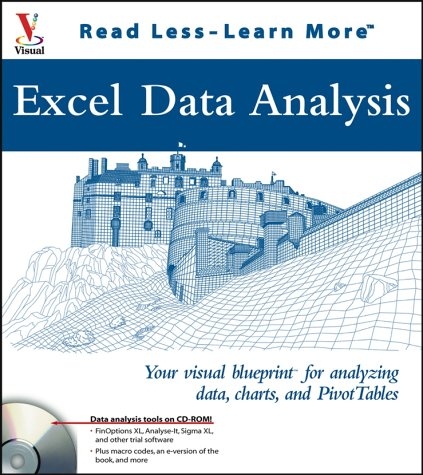
Excel Data Analysis
Hungry Minds Inc,U.S. (Verlag)
978-0-7645-3754-7 (ISBN)
- Titel ist leider vergriffen;
keine Neuauflage - Artikel merken
This work is essential for those who know basic Excel and want to explore the full potential of the program. It teaches how to manipulate data to suit specific needs and achieve more by doing less work. Self-contained two-page lessons, featuring high-resolution screen shots and minimal text, show how to create custom functions, retrieve data from databases, use value chains, and slice and pivot information from the Web with Excel's PivotTable utility. It covers data analyzing techniques for statistical functions, financial functions, data sharing, PivotTables and PivotCharts, Solver, and BackSolver.
Jinjer Simon has been actively involved in the computer industry for the past 18 years. Her involvement in the industry has included programming, providing software technical support, training end--users, developing written and online user documentation, creating software tutorials, and developing Web sites. She is the author of several computer books, including Excel Programming: Your visual blueprint for creating interactive spreadsheets, Windows CE For Dummies, and Windows CE 2 For Dummies.
HOW TO USE THIS BOOK. 1) GETTING STARTED WITH EXCEL. Excel Data Analysis Options. Excel Data Types. Locate a Value in a Worksheet. Select a Range of Cells. Name a Range. Create Label Ranges. Modify Named Ranges. Copy and Paste a Range of Cells. Create a Custom Number Format. Apply AutoFormat to a Worksheet. Create a Named Style. Create a Custom Template. Protect Worksheets. 2) ORGANIZE WORKSHEET DATA. Create a List. Add a Series to a List. Sort a List. Create a Custom Sort. Consolidate Data. Outline Your Data. 3) EVALUATE WORKSHEET DATA. Apply Conditional Formatting. Summarize Data with Subtotals. Filter a List. Create a Custom Filter. Create an Advanced Filter. Create Scenarios. Validate Data. 4) CREATING FORMULAS. Sum Cells with the AutoSum Button. Add a Function via the Insert Function Dialog Box. Edit Formulas. Evaluate a Formula. Using Solver to Produce Specific Values. Create a Conditional Formula. Solve a Formula with a Data Table. Trace a Formula Error. Look Up a Value in a Specific Row and Column. Determine the Location of a Value. Return a Value at a Specific Location in a Data List. Rank a Value within a Data List. Create an Amortization Table for a Loan. 5) WORKING WITH EXTERNAL DATA. Link Data to Other Windows Programs. Import a Delimited Text File. Divide a Column into Multiple Columns. Create a Web Query. Import a Database Table. Using Queries to Screen External Databases. Find the Average of a Database Range. Save For Web. 6) CHARTING DATA. Chart Basics. Modify a Chart Type. Explode Slices of a Pie Chart. Create a Custom Chart Type. Add a Trendline to a Chart. Add or Change New Data to a Chart. Create a Chart with Multiple Chart Types. 7) WORKING WITH PIVOTTABLE REPORTS. PivotTable Basics. A View of the PivotTable Report Fields. Create a PivotTable Report from an Excel List. Change the Layout of a PivotTable. Filter a Field. Change the Calculation of a Data Field. Group PivotTable Data Items. Add Another Data Area Calculation. Add a Calculated Field. Add a Calculated Item. Retrieve a Value from a PivotTable Report. 8) CREATING PIVOTCHARTS. Create a PivotChart from an External Database. Change the Layout of a PivotChart. Change the Chart Type of a PivotChart. Filter a PivotChart Field. Group Items in a PivotChart Field. Add a Data Table to a PivotChart. 9) AUTOMATING ACTIONS WITH MACROS. An Introduction to Macros. Record a Macro. Run a Macro. Activate the Visual Basic Editor. Create a Macro Using the Visual Basic Editor. Update a Recorded Macro. Set Macro Security. Create a Custom Function. Declare a Variable. Execute a Task a Specific Number of Times. Display a Message Box. Request User Input for a Macro. Assign a Macro to a Menu. Run a Macro As a Workbook Opens. Using an Excel Function in a Macro. 10) FORM CONTROLS. An Introduction to Forms. The Forms Toolbar. VBA Dialog Box Basics. Add a Form Control to a Worksheet. Specify Values for a Form Control. Customize Form Controls with Macros. Create a Custom Dialog Box. Call a Custom Dialog Box from a Macro. Capture Input from a Custom Dialog Box. Validate Input from a Dialog Box. 11) USING THE ANALYSIS TOOLPACK ADD--INS. Install Excel Add--ins. Using the Conditional Sum Wizard. Analysis of Variance for Lists of Values (ANOVA). Find the Correlation Between Two Sets of Data. Determine the Covariance of Two Sets of Data. Calculate Descriptive Statistics. Compare the Variances in Two Groups of Data. Calculate a Moving Average. Determine Rank and Percentile. APPENDIXES. Appendix A: Excel Keyboard Shortcuts. Appendix B: Excel Function Quick Reference. Appendix C: VBA and Excel Events Quick Reference. Appendix D: Formula Basics in Excel. Appendix E: What's on the CD--ROM. INDEX.
| Erscheint lt. Verlag | 11.4.2003 |
|---|---|
| Zusatzinfo | Illustrations |
| Verlagsort | Foster City |
| Sprache | englisch |
| Maße | 80 x 89 mm |
| Gewicht | 680 g |
| Einbandart | Paperback |
| Themenwelt | Informatik ► Office Programme ► Excel |
| ISBN-10 | 0-7645-3754-7 / 0764537547 |
| ISBN-13 | 978-0-7645-3754-7 / 9780764537547 |
| Zustand | Neuware |
| Haben Sie eine Frage zum Produkt? |
aus dem Bereich


